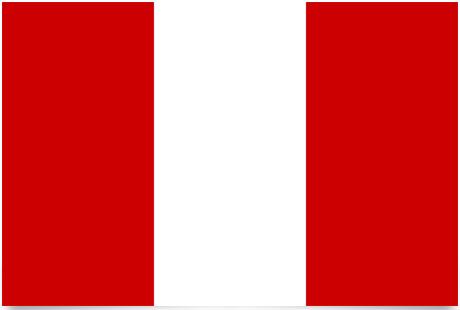Peru Flag and Meaning
Flag of Peru

Peru Flag Meaning
According to tradition, the freedom hero José de San Maritin, when he saw a flock of red-and-white flamingos take off, said ?? This will be the flag of freedom! ??. As he said, so be it and the red and white flag is the symbol of the struggle against Spain for Peru’s freedom. From the beginning there was also a sun on the flag, it was removed by Simon Bolivar in 1825 and the current flag was adopted on 25 February the same year. The sun and also the colors in the flag are old Inca symbols.
Peru’s state and army flags have two differently designed emblems in the middle, but with the same symbols. There are coats of arms that show the llama animal vikunja, the Chinese tree and a cornucopia full of gold money.
Peru Overview
| Population | 25.7 million |
| Currency | New soles |
| Area | 1.285.220 km² |
| Capital city | Lima |
| Population density | 19.9 residents/km² |
| HDI location | 63 |
The Andes mountain chain divides the country into 3 regions: the coastal signs, the highlands and the Amazon jungle. The coastal area is desert-like but with large plantations (especially sugar and cotton) based on irrigation – historically the country’s most modern and western-oriented part. About half of the population lives in the highlands – mostly between the two ridge of the Andean chain. The majority of farmers organized in ayllus, there is an old form of society with features from the Incas community. Agriculture is a subsistence farming based on the cultivation of maize and potatoes. The llama and alpaca team have been forced back to the most remote areas of the highlands as a result of widespread mining and sheep farming. The lowland to the Amazon jungle in the east is sparsely populated and characterized by tropical climate. Peru is one of the world’s largest producers of the coca plant, which has medicinal properties, has traditionally been used in the indigenous culture and is today artificially processed into cocaine. The country is suffering from the depletion of the already poor soils. Overfishing has drastically reduced the presence of certain fish species, and the coastal area is generally polluted by emissions from industries and households.
The People: Nearly half of the country’s population is based on the indigenous peoples of Quechua and Aymara, which are the two largest groups of people in the country. In the coastal area, the mestiz population – the mix of Spanish conquerors and natives – is dominant as well as small communities of descendants of African slaves. In the Amazon there are a number of smaller ethnic groups.
Religion: Catholicism (official and dominant) – though often mixed with the native rituals of the indigenous people.
Languages: Spanish, Quechua, Aymara (official)
Political parties: In the 1995 elections, none of the traditional parties received more than 5% of the votes needed to take part in future elections. They must therefore collect signatures in order to become eligible again.
Perú Posible (Peru Possible) led by Alejandro Toledo; Allianza Popular Revolucionaria Americana (APRA Social Democracy), formed in 1930; Unidad Nacional (National Unit); Frente Independiente Moralizador (The Independent Moralizing Front); Somos Perú (We are Peru); Cambio 90-Nueva Mayoría, (Change 90 – New Majority), formed in 1989 by Alberto Fujimori; Acción Popular (AP, People’s Action), led by Fernando Belaúnde Terry; Union por el Peru (Union of Peru); Izquierda Unida (IU, United Left), consisting of Frente Nacional de Trabajadores y Campesinos (Workers and Peasants National Front), Partido Comunista Peruano (Peru Communist Party) and Unión de Izquierda Revolucionaria (Revolutionary Left Union); Izquierda Socialista (Socialist Left) led by Alfonso Barrantes, who broke with IU in 1990.
Guerrilla Movements: Movimiento Revolucionario Tupac Amaru (MRTA, Revolutionary Movement Tupac Amaru); Partido Comunista del Peru – Sendero Luminoso (Peru Communist Party – Sendero Luminoso), movement with Maoist background.
Social organizations: Central General de Trabajadores Peruanos (CGTP, Peruvian Workers Main Center) formed in 1928 and communist-oriented. Central de Trabajadores Peruanos (CTP, Peruvian Workers’ Central), formed in 1944 and affiliated with APRA; Confederación Nacional de Trabajadores (CNT, Workers’ National Confederation), formed in 1971, independent; Central de Trabajadores de la Revolución Peruana (CTRP, Association of Peruvian Revolutionary Workers), created in 1972 by workers who were then supporters of the then military commander and President Velazguez. In March 1991, the four national organizations formed the Coordinadora Nacional de Centrales Sindicales (CNCS), as a step forward towards the creation of a single national organization. Confederación Nacional Agraria (CNA, National Soil Confederation) formed in 1972.
Official name: República del Perú
Administrative Division: 25 departments divided into 155 provinces divided into 1,586 districts.
Capital: Lima, 7,605,000 (2007)
Other important cities: Arequipa, 720,400 residents; Trujillo, 520,200 residents; Chiclallo, 481,100 residents; Cuzco, 279,600 residents (2000).
Government: Pedro Pablo Kuczynski, President since July 2016. Mercedes Aráoz, Prime Minister since September 2017. Parliament has a chamber with 120 seats.
National Day: July 28 (Independence Day, 1821)
Armed forces: 125,000 soldiers. Of these, 65,000 conscripts. 188,000 in reserve (1996)
Paramilitary forces: 60,000 (National Police). 600 (Coast Guard). In addition, the military has formed 2,000 Rondas Campesinas – self-defense groups in the countryside in the state of emergency.













































